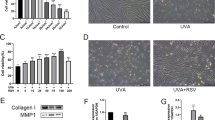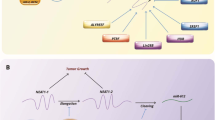Abstract
Keloid is a skin disease characterized by fibrous hyperplasia, which is often difficult to cure. Long non-coding RNAs (lncRNAs) have been shown to be associated with the development of many diseases. However, the role and mechanism of lncRNA H19 in keloid has been less studied. Our study found that lncRNA H19 expression was increased in keloid tissues and fibroblasts. Besides, H19 knockdown hindered the proliferation, migration, invasion, extracellular matrix (ECM) deposition, and enhanced the apoptosis of keloid fibroblasts. Further experiments showed that microRNA (miR)-769-5p could be sponged by H19, and its knockdown reversed the suppression effect of H19 knockdown on keloid formation. Eukaryotic initiation factor 3A (EIF3A) was found to be a target of miR-769-5p, and its overexpression inverted the inhibition effect of miR-769-5p overexpression on keloid formation. Moreover, the expression of EIF3A was regulated by H19 and miR-769-5p in keloid fibroblasts. Collectively, LncRNA H19 might play an active role in keloid formation, which might provide a new target for the treatment of keloid.








Similar content being viewed by others
References
Diao JS, Xia WS, Yi CG, Wang YM, Li B, Xia W, Liu B, Guo SZ, Sun XD (2011) Trichostatin a inhibits collagen synthesis and induces apoptosis in keloid fibroblasts. Arch Dermatol Res 303:573–580. https://doi.org/10.1007/s00403-011-1140-1
Unahabhokha T, Sucontphunt A, Nimmannit U, Chanvorachote P, Yongsanguanchai N, Pongrakhananon V (2015) Molecular signalings in keloid disease and current therapeutic approaches from natural based compounds. Pharm Biol 53:457–463. https://doi.org/10.3109/13880209.2014.918157
Halim AS, Emami A, Salahshourifar I, Kannan TP (2012) Keloid scarring: understanding the genetic basis, advances, and prospects. Arch Plast Surg 39:184–189. https://doi.org/10.5999/aps.2012.39.3.184
Bock O, Schmid-Ott G, Malewski P, Mrowietz U (2006) Quality of life of patients with keloid and hypertrophic scarring. Arch Dermatol Res 297:433–438. https://doi.org/10.1007/s00403-006-0651-7
Juckett G, Hartman-Adams H (2009) Management of keloids and hypertrophic scars. Am Fam Physician 80:253–260
Wolfram D, Tzankov A, Pulzl P, Piza-Katzer H (2009) Hypertrophic scars and keloids--a review of their pathophysiology, risk factors, and therapeutic management. Dermatol Surg 35:171–181. https://doi.org/10.1111/j.1524-4725.2008.34406.x
Liang X, Ma L, Long X, Wang X (2015) LncRNA expression profiles and validation in keloid and normal skin tissue. Int J Oncol 47:1829–1838. https://doi.org/10.3892/ijo.2015.3177
Kwok ZH, Tay Y (2017) Long noncoding RNAs: lincs between human health and disease. Biochem Soc Trans 45:805–812. https://doi.org/10.1042/BST20160376
Li Y, Liang X, Wang P, Long X, Wang X, Meng Z (2018) Long non-coding RNA CACNA1G-AS1 promotes calcium channel protein expression and positively affects human keloid fibroblast migration. Oncol Lett 16:891–897. https://doi.org/10.3892/ol.2018.8717
Jin J, Zhai HF, Jia ZH, Luo XH (2019) Long non-coding RNA HOXA11-AS induces type I collagen synthesis to stimulate keloid formation via sponging miR-124-3p and activation of Smad5 signaling. Am J Physiol Cell Physiol 317:C1001–C1010. https://doi.org/10.1152/ajpcell.00319.2018
Zhou Y, Fan RG, Qin CL, Jia J, Wu XD, Zha WZ (2019) LncRNA-H19 activates CDC42/PAK1 pathway to promote cell proliferation, migration and invasion by targeting miR-15b in hepatocellular carcinoma. Genomics 111:1862–1872. https://doi.org/10.1016/j.ygeno.2018.12.009
Zhang Y, Zhu R, Wang J, Cui Z, Wang Y, Zhao Y (2019) Upregulation of lncRNA H19 promotes nasopharyngeal carcinoma proliferation and metastasis in let-7 dependent manner. Artif Cells Nanomed Biotechnol 47:3854–3861. https://doi.org/10.1080/21691401.2019.1669618
Zhao Y, Feng C, Li Y, Ma Y, Cai R (2019) LncRNA H19 promotes lung cancer proliferation and metastasis by inhibiting miR-200a function. Mol Cell Biochem 460:1–8. https://doi.org/10.1007/s11010-019-03564-1
Li J, Cao LT, Liu HH, Yin XD, Wang J (2019) Long non coding RNA H19: an emerging therapeutic target in fibrosing diseases. Autoimmunity:1–7. https://doi.org/10.1080/08916934.2019.1681983
Zhang J, Liu CY, Wan Y, Peng L, Li WF, Qiu JX (2016) Long non-coding RNA H19 promotes the proliferation of fibroblasts in keloid scarring. Oncol Lett 12:2835–2839. https://doi.org/10.3892/ol.2016.4931
Salmena L, Poliseno L, Tay Y, Kats L, Pandolfi PP (2011) A ceRNA hypothesis: the Rosetta stone of a hidden RNA language? Cell 146:353–358. https://doi.org/10.1016/j.cell.2011.07.014
Xian Y, Wang L, Yao B, Yang W, Mo H, Zhang L, Tu K (2019) MicroRNA-769-5p contributes to the proliferation, migration and invasion of hepatocellular carcinoma cells by attenuating RYBP. Biomed Pharmacother 118:109343. https://doi.org/10.1016/j.biopha.2019.109343
Kashiyama K, Mitsutake N, Matsuse M, Ogi T, Saenko VA, Ujifuku K, Utani A, Hirano A, Yamashita S (2012) miR-196a downregulation increases the expression of type I and III collagens in keloid fibroblasts. J Invest Dermatol 132:1597–1604. https://doi.org/10.1038/jid.2012.22
Yin JY, Zhang JT, Zhang W, Zhou HH, Liu ZQ (2018) eIF3a: a new anticancer drug target in the eIF family. Cancer Lett 412:81–87. https://doi.org/10.1016/j.canlet.2017.09.055
Li T, Zhao J (2018) Knockdown of elF3a inhibits TGFbeta1induced extracellular matrix protein expression in keloid fibroblasts. Mol Med Rep 17:4057–4061. https://doi.org/10.3892/mmr.2017.8365
DiStefano JK (2018) The emerging role of Long noncoding RNAs in human disease. Methods Mol Biol 1706:91–110. https://doi.org/10.1007/978-1-4939-7471-9_6
Yuan C, Bu W, Li L, Zhang M, Chen K, Fang F, Li M, Chen X, Gu H (2017) Long non-coding RNA expression profiling in the lesional tissue and derived fibroblasts of keloid. Postepy Dermatol Alergol 34:587–600. https://doi.org/10.5114/ada.2017.72466
Li H, Nahas Z, Feng F, Elisseeff JH, Boahene K (2013) Tissue engineering for in vitro analysis of matrix metalloproteinases in the pathogenesis of keloid lesions. JAMA Facial Plast Surg 15:448–456. https://doi.org/10.1001/jamafacial.2013.1211
Shih B, Garside E, McGrouther DA, Bayat A (2010) Molecular dissection of abnormal wound healing processes resulting in keloid disease. Wound Repair Regen 18:139–153. https://doi.org/10.1111/j.1524-475X.2009.00553.x
Mohamed MS, Bishr MK, Almutairi FM, Ali AG (2017) Inhibitors of apoptosis: clinical implications in cancer. Apoptosis 22:1487–1509. https://doi.org/10.1007/s10495-017-1429-4
Barbazan J, Matic Vignjevic D (2019) Cancer associated fibroblasts: is the force the path to the dark side? Curr Opin Cell Biol 56:71–79. https://doi.org/10.1016/j.ceb.2018.09.002
Cavaco A, Rezaei M, Niland S, Eble JA (2017) Collateral damage intended-cancer-associated fibroblasts and vasculature are potential targets in cancer therapy. Int J Mol Sci:18. https://doi.org/10.3390/ijms18112355
Bhattacharjee O, Ayyangar U, Kurbet AS, Ashok D, Raghavan S (2019) Unraveling the ECM-immune cell crosstalk in skin diseases. Front Cell Dev Biol 7:68. https://doi.org/10.3389/fcell.2019.00068
Yan L, Wang LZ, Xiao R, Cao R, Pan B, Lv XY, Jiao H, Zhuang Q, Sun XJ, Liu YB (2019) Inhibition of microRNA-21-5p reduces keloid fibroblast autophagy and migration by targeting PTEN after electron beam irradiation. Lab Investig. https://doi.org/10.1038/s41374-019-0323-9
Wang R, Bai Z, Wen X, Du H, Zhou L, Tang Z, Yang Z, Ma W (2019) MiR-152-3p regulates cell proliferation, invasion and extracellular matrix expression through by targeting FOXF1 in keloid fibroblasts. Life Sci 234:116779. https://doi.org/10.1016/j.lfs.2019.116779
Zhu W, Wu X, Yang B, Yao X, Cui X, Xu P, Chen X (2019) miR-188-5p regulates proliferation and invasion via PI3K/Akt/MMP-2/9 signaling in keloids. Acta Biochim Biophys Sin Shanghai 51:185–196. https://doi.org/10.1093/abbs/gmy165
Funding
No funding was received.
Author information
Authors and Affiliations
Contributions
All authors made substantial contribution to conception and design, acquisition of the data, or analysis and interpretation of the data; take part in drafting the article or revising it critically for important intellectual content; gave final approval of the revision to be published; and agree to be accountable for all aspect of the work.
Corresponding author
Ethics declarations
Conflict of interest
The authors declare that they have no competing interests.
Ethical approval
The present study was approved by the ethical review committee of The First Affiliated Hospital of Zhengzhou University. Written informed consent was obtained from all enrolled patients.
Additional information
Publisher's Note
Springer Nature remains neutral with regard to jurisdictional claims in published maps and institutional affiliations
Rights and permissions
About this article
Cite this article
Xu, L., Sun, N., Li, G. et al. LncRNA H19 promotes keloid formation through targeting the miR-769-5p/EIF3A pathway. Mol Cell Biochem 476, 1477–1487 (2021). https://doi.org/10.1007/s11010-020-04024-x
Received:
Accepted:
Published:
Issue Date:
DOI: https://doi.org/10.1007/s11010-020-04024-x




